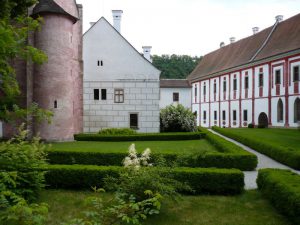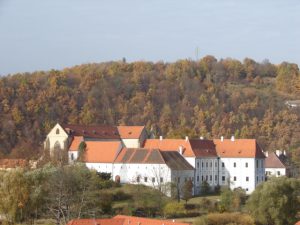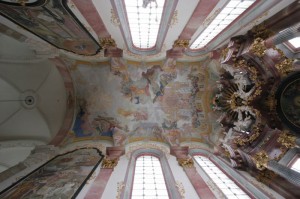Zlatá Koruna
By Tracy A. Burns
Located a mere six kilometers from picturesque and romantic Český Krumlov, next to the Vltava River, is the monastery of Zlatá Koruna (The Golden Crown), founded by King Otakar II of the Přemyslid dynasty in 1263 for the Cistercian Order. According to a legend, King Otakar II promised to establish a monastery and dedicate it to the Virgin Mary if he won the Battle of Kressenbrunn in 1260. He was victorious and kept his promise.
The Hussites Come to Town
The monastery was burned down by the Hussites during the Hussite Wars in 1420, and a legend harkens back to those tragic days. It is said that when the Hussites captured monks who were not able to escape, they killed them utilizing one of three methods. They used a weapon, burned them at the stake or hanged them from a linden tree.
Some Happier and Some Sadder Days
The monastery was reconstructed in the 17th century and at the start of the 18th century. Zlatá Koruna suffered yet more hardships at the end of the 18th and beginning of the 19th centuries when it was used as a factory. After the factory was closed in 1909, reconstruction began and continued even through World War II, when the Nazi Protectorate took it away from the Schwarzenbergs, its former owners. Nationalized in 1948, the monastery acquired the status of a national cultural monument in 1995.
The Present
 Comprised of a three-aisle basilica, big and small convent buildings, and a chapel, the monastery flaunts elaborate Rococo stucco décor and numerous Rococo wall paintings in its interior. The Refectory, the former monastery dining room, features three early Baroque frescoes dating from 1685. The painting at the door shows prophet Habakkuk with an angel. The middle fresco focuses on The Holy Trinity theme. Another fresco is devoted to Hagar with his son Ishmael and an angel. A huge canvas telling the story of Josef in Egypt hangs in the entranceway. Another painting from the late 18th century portrays Saint John of Nepomuk.
Comprised of a three-aisle basilica, big and small convent buildings, and a chapel, the monastery flaunts elaborate Rococo stucco décor and numerous Rococo wall paintings in its interior. The Refectory, the former monastery dining room, features three early Baroque frescoes dating from 1685. The painting at the door shows prophet Habakkuk with an angel. The middle fresco focuses on The Holy Trinity theme. Another fresco is devoted to Hagar with his son Ishmael and an angel. A huge canvas telling the story of Josef in Egypt hangs in the entranceway. Another painting from the late 18th century portrays Saint John of Nepomuk.
Other Spaces to View
The Chapel of Guardian Angels is the oldest preserved part of the monastery, a gem of early Czech Gothic architecture, dating back to the late 13th century. Its exquisite Rococo frescoes hail from 1763. The Chapter Hall, built in 13th-century Gothic style, houses Rococo paintings portraying religious allegories. The Cruciform Passage section of the Big Convent is notable for its rich Rococo stucco decoration and frescoes that illustrate scenes from the history of the Cistercian Order. The Church of the Annunciation of the Virgin Mary is also dominated by stucco decoration. The main altar, adorned with sculptures, dates from the late 18th century. Don’t miss the High Gothic rose window in the transept.
Epitaphs
The epitaphs of Přemysl Otakar II and of Bavor II are on display as well. Take a look at the epitaph of Přemysl Otakar II. It consists of an empty coffin opened by the god Saturn with Pallas Athena standing at his side. Designed circa 1772 by Jakub Eberle, the epitaph boasts rich sculptural decoration and twisting figures. In the abbey pay special attention to a ceiling painting that depicts the founding of the monastery.
Literature and Lapidary
On the second tour of the monastery, the visitor becomes well-acquainted with the literature of the southern Bohemia and eastern Šumava regions. There is also a lapidary with impressive statues. After experiencing the architectural grandeur of Zlatá koruna, take a walk across the bridge to the other side of the Vltava River, where you can relax on the embankment and gaze at the monastery, awed by its astounding history and splendor.






